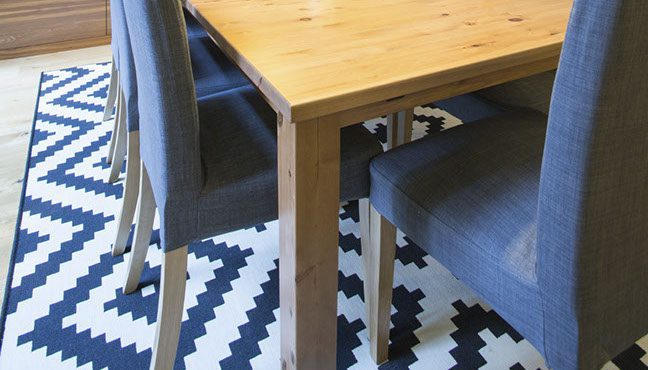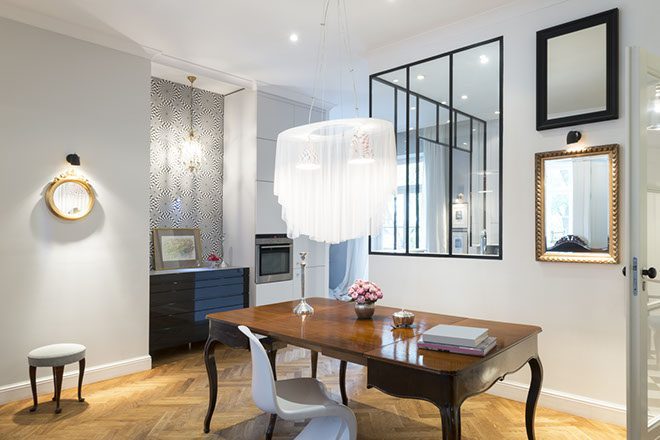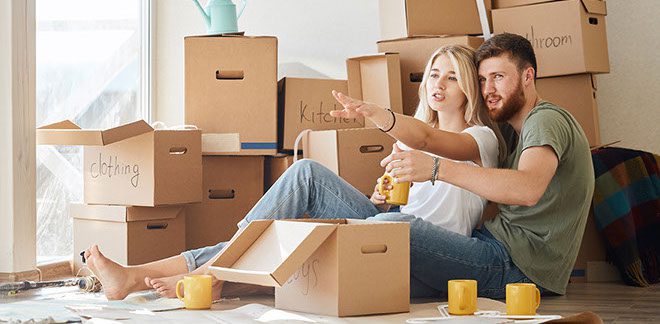Tips for picking the perfect rug
Tips for picking the perfect rug
When buying a rug there’s a lot more to choose than just colour. So thinking about what you need in advance can ensure you get the right rug for you.
Pile depth
If you’ve got pets, a thick deep pile rug might seem like a cosy place for them to sleep, but it will attract hairs and be hard to keep clean. Maintenance is an important consideration when it comes to picking a rug and pile depth is crucial to that. For areas with high foot fall, maintenance will be much easier if you get a harder rug with shallow pile. Softer rugs are also going to wear out quicker. If the rug is for your dining room or kitchen a shallow pile rug will be much easier to keep clean in the case of spillages. So think about what you need the rug for and what sort of use it’s going to get to make sure you get the right one.
Size
A well-chosen rug can completely change the feel of a room. But getting the wrong size can overwhelm a space and make it look small. A rug shouldn’t really be a substitute for a carpet, and you don’t need it to cover every inch floor space. So picking the right size is really about thinking about the area it needs to cover. Plan your room, arrange the furniture, and then measure out the space you want to cover.
A rug is great for breaking up big blank areas in a room, or for hovering items of furniture to sit on. In a lounge, a large rug can look good as a centre piece, with a coffee table on top, in a bedroom on the other hand, a much smaller rug would be more suitable at the foot or side of the bed.
Placement
Placement is even more important than size and is a vital aspect of the styling of your room. A rug clearly needs to fit in with the layout of the furniture and complement the look of the room. While rugs in hallways might simply be to protect the carpet, rugs in bedrooms and bathrooms need to be placed to best benefit the purpose (such as to avoid treading on cold wooden floors or tiles). In lounges rugs can be used for furniture to sit on to soften the lines of a room. It is fairly simple to position a rectangular carpet well – by making sure the edges run parallel with the walls, but circular or oval carpets are a whole different ball game and need to line up well with your furniture.
Colour
Rug colours obviously need to complement the scheme you already have, but that doesn’t mean you have to match everything up perfectly. A rug is a separate feature in itself so you should certainly try to make it stand out from the floor colouring you already have. Texture is also part of this. A deep rich colour might look good in contrast to a light floor, likewise a lighter colour might sit well on dark wooden flooring. Where you have kept your flooring neutral, rugs can be a great way to add a pop of colour to liven up a room design.
Shape
Rectangular rugs are, of course, the most common, and the simplest to position in a room. But going off piste a bit with your rug shape can again emphasise it as a key feature of a room and add to a classy design. A modern layout with lots of clear straight lines might actually benefit a circular rug a bit different from the norm to give your room a new perspective.
Style
Style is often the first thing you think about when it comes to rugs, and, let’s face it, it’s definitely one of the most important. That said it’s worth thinking about all the other points first and then turning to style, otherwise you might end up buying a great looking rug that just doesn’t suit your room. Rugs should complement a room, rather than match it perfectly, which is why going for a vibrant pattern can often be a really stylish choice. Still, the style of your rug should be down to your own tastes and is your choice alone.
For more great tips visit www.drytron.com.au. Of course, if you need to get your rug cleaned by the experts, simply give us a call in the Drytron Customer Care Centre on 13 12 50.

10 smart ideas for small spaces
10 smart ideas for small spaces
When designing for a small space it’s all about being smart. If you can’t knock out walls to make the room bigger, there are several things you can do to make it feel bigger. You don’t need to compromise style and comfort when you’re faced with reduced dimensions. Here is a list of 10 smart ideas for small spaces:
1. White or light colours
These colours reflect light instead of absorbing it, opening up the space straight away. If you have dark wooden floors and walls, paint over them in white or another light colour and brighten up your room. Or if you love your dark floorboards you can always invest in a beautiful cream or light coloured rug to give some extra light.
2. Sliding doors
Instead of hinged cupboard doors that open out and block pathways. Install sliding doors and glide around with ease.
3. Mirrors
Magnify your small space with a nice big mirror. If you have a beautiful view from a window place your mirror opposite it to reflect the outdoors to open up the space. You can also use a floor length mirror behind a piece of furniture to give it purpose instead looking crammed in.
4. Storage Storage Storage
You would be amazed at where you can store things you don’t need on display. Under a bed. Under a table. Under a staircase. Above a fridge. Narrow shelves on empty walls. And always build built-in storage if the space allows.
5. Clever curtains
Make your space feel organised and less cluttered. Use curtains (big and small) in the bedroom to conceal a messy wardrobe or shoe rack, under the bed or under a side table.
6. Think Multipurpose
You don’t have room for lots of items so just pick a few and make sure they have at least two functions. A table with storage underneath and maybe even splits and goes up against a wall or extends. A washer and dryer in one. A dining room banquette with storage underneath that doubles as a guest bed. The possibilities are endless.
7. Love Levels
If your ceiling height permits, build a small loft area for your bed with a small ladder to climb up. Not only will you save space but it’s such a fun way to go to bed.
8. Wall space is sacred
When you’re faced with small, it makes sense to go vertical. Use hooks and shelves to store items so you keep as much floor space free as possible. Buy or build storage solutions that maximise your wall space. Think Wall-to-wall and floor-to-ceiling. And if you haven’t found your small space yet but you’re looking for one, choose one with nice high ceilings and windows. You get more wall space for storage and decoration, plus the space will actually be bigger.
9. Clear furniture
It might sound strange, but think of how much extra light you will get in your space with a clear plastic chair, or a nice glass table.
10. Lots of light
Place a collection of lamps around your small space. Lamps instantly make the room feel warmer and more intimate rather than crowded.
For more great tips visit www.drytron.com.au. Of course, if you need to get your carpet, rugs and upholstery cleaned and looking their best, simply give us a call in the Drytron Customer Care Centre on 13 12 50.

What Does it Cost to Move House?
What Does it Cost to Move House?
Moving home can be very a very exciting time. Whether you’re moving across town or to a new city, a new life chapter awaits. Perhaps you’ve bought your first home, are upgrading your home, or moving to start a new job. Whatever the reason, moving house marks an important time in your life, but it can end up costing more than you may have initially anticipated.
There are number of obvious costs associated with moving house, such as hiring a professional removal company, but there are also several costs that are somewhat hidden, that can add up and make the move quite expensive. Additional expenses can often compound the stress of moving especially if you’re unprepared, or if they come up unexpectedly.
The total cost of a move depends on a number of things; how well you plan for your move, the amount of furniture you have to move, the distance you’re moving and how much of the work you do yourself.
Here’s a Summary of the Costs Related With Moving House:
Furniture Mover:
Cost: Varies
The major cost associated with moving house is hiring a professional removalist. The cost varies depending on a range of factors; such as how the distance you’re moving and how many items need to be moved. These factors influence the amount of time the removalist service will be assisting with your move.
Some other factors that can impact the total cost are the level of service you need, such as if you’d like them to do all of packing and unpacking, house cleaning, insurance, pet and car transportation, and any storage requirements. To get an idea for how much it will cost, call a few removalist companies for a free quote.
Cleaning:
Approximate Cost: $200 for a professional depending on your home’s size, $20 for DIY
When you move, you should give the place a thorough clean inside and out for those moving in. You may also find that at the new place your moving into, the previous occupiers have left the place in need of some TLC.
Hiring a cleaner is a great way to reduce stress and manual tasks on a day that is already filled with lots of heavy lifting. Plus, for carpets, a professional carpet cleaning service is likely to be the only way to get the result you need. For other areas, you can do the cleaning yourself by purchasing a few basic items such as some bleach, multi-purpose cleaner, glass cleaner and a few rags.
Moving Materials:
Approximate Cost: $80
You’re doing the move yourself, there are a few things you’ll need to purchase or organise and purchase such as boxes, duct tape, permanent marker pens, bubble wrap and more. The bigger or more expensive the item, the more effort you should make in protecting it during transit.
Trailer or Moving Truck:
Approximate Cost: $100 (excluding petrol and straps)
You’ll also need a trailer or moving trick if you move yourself. A trailer also means you’ll need a vehicle with a tow bar, or you’ll need to borrow one. You should also factor in petrol costs for the car or truck. Naturally, the longer the distance the more fuel you will need, and the longer you will need to hire the trailer for.
You’ll also need to get a hold of some robust straps and ropes to keep everything in place during transit. You can borrow these from someone who already owns them, or you can purchase them from somewhere like Bunnings.
Redirects and Reconnections:
Approximate Cost: $100
Moving home means you’ll need to get your services and utilities disconnected from your old home and reconnected in your new one. Some companies can charge for this service, particularly if you have decided to change utility providers. You also need to get your mail redirected to your new home, so your mail doesn’t get delivered to your old address.
Storage (Long or Short Term):
Approximate Cost: From $250 a month
If your settlements don’t align, you may require short or long-term storage. You may need to find somewhere to store your furniture for a several days, or even a few weeks or months.
The cost of storage varies depending on how much furniture you need to put in storage and the duration. Alternatively, consider storing some furniture at a family member or friend’s garage. This will help to keep costs down.
Transit Insurance:
Approximate Cost: $150+
It pays to be protected on moving day, especially if you have valuable or fragile items. Transit insurance offers protection for damaged items and is something you should strongly consider when calculating the overall cost of moving.
Many removalist companies offer insurance, however if you are moving furniture yourself, your belongings will be unprotected.
If you don’t plan carefully, the cost of moving can really add up. Although a DIY move may initially seem like the cheaper option, factoring in all costs associated and the lack of protection for your belongings can end up costing you more. Not to mention the time and stress it is likely to cause. Gather quotes from all required services and work out what best suits your budget.
John Ryan Removals are experienced removalists in Melbourne, offering a full range of services. Reach out to them for a free quote. www.johnryan.com.au
